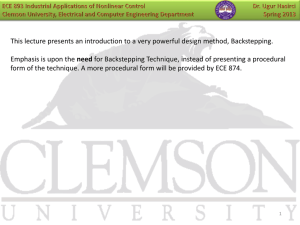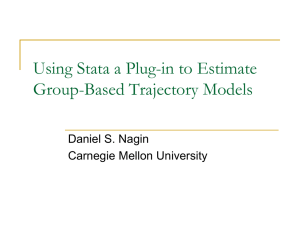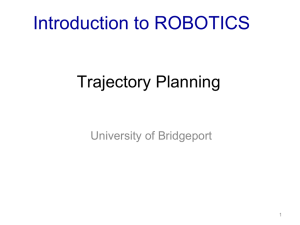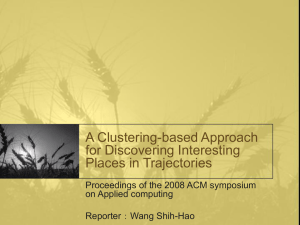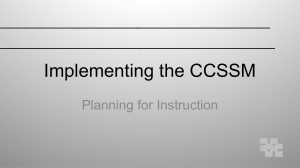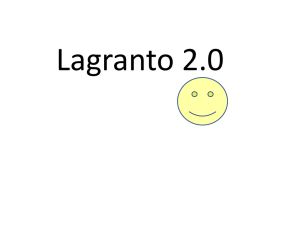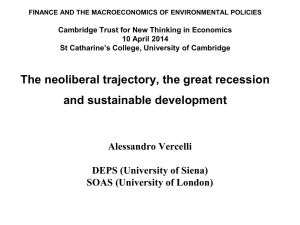05-Trajectory Pattern Mining
advertisement
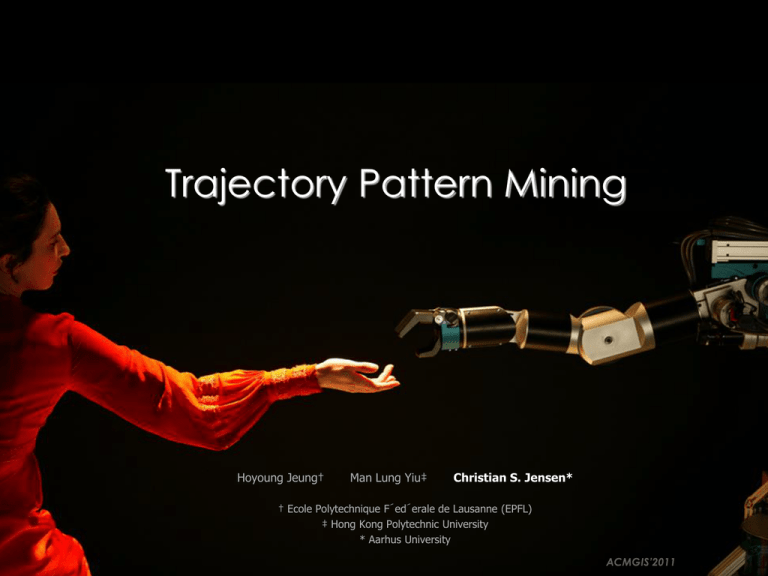
Trajectory Pattern Mining Hoyoung Jeung† Man Lung Yiu‡ Christian S. Jensen* † Ecole Polytechnique F´ed´erale de Lausanne (EPFL) ‡ Hong Kong Polytechnic University * Aarhus University ACMGIS’2011 Introduction & Overview Relative Motion Patterns Disc-Based Trajectory Patterns Density-Based Trajectory Patterns Conclusion Introduction Increasing location-awareness – Drowning in trajectory data, but starving for knowledge. Trajectory pattern mining – An emerging and rapidly developing topic in data mining. – Concerns the grouping of similar trajectories. Applications and uses – – – – – Transportation optimization Prediction Animal movement analyses, social analyses Team sports events analyses Traffic analyses Pattern Discovery Process Classifying Trajectory Patterns Mining tasks on trajectories – Clustering of trajectories • Group trajectories based on geometric proximity in spatial/spatiotemporal space. – Trajectory join • Given two trajectory datasets, retrieve all pairs of similar trajectories. Spatial and spatiotemporal patterns Classifying Trajectory Patterns Granularity of trajectory patterns – Global vs. partial patterns. • Global: basic unit of pattern discovery is a whole trajectory. • Partial: concerns sub-trajectories to discover patterns of some duration. – Individual vs. group patterns. • Individual: regular patterns of an individual. • Group: common patterns of different objects. Constrained trajectory patterns – Spatial constraints: movement on spatial networks. – Temporal constrains: periodicity. Introduction & Overview Relative Motion Patterns Disc-Based Trajectory Patterns Density-Based Trajectory Patterns Conclusion Relative Motion Patterns Overview Key features – Identify similar movements in a collection of moving-object trajectories. – REMO (RElative MOtion): analysis concept. • Transform raw trajectories into motion attributes (speed, motion azimuth). Pattern types – Basic motions: constance, concurrence, trendsetter. – Spatial motions: track, flock, leadership. – Aggregate/segregate motions: convergence, encounter, divergence, breakup. [GIScience'02, IJGIS'05,SDH'04,CEUS'06] Basic Motion Patterns Concept – Describing motion events, disregarding absolute positions. Definitions – Constance: a sequence of equal motion attributes for consecutive times. – Concurrence: the incidence of multiple objects with the same motion attributes. – Trendsetter: a certain motion pattern that is shared by a set of other objects in the future. E.g., “constance” + “concurrence.” constance concurrence trendsetter Spatial Motion Patterns Concept – Basic motion patterns + spatial constraint (region) Definitions – Track: individual objects, each travels within a range while keeping the same motion. “constance” + a spatial constraint. – Flock: a set of objects who travel within a range while keeping the same motion. “concurrence” + a spatial constraint. – Leadership: one leader followed by a set of objects with the same motion. “trendsetter” + a spatial constraint. Aggregate/Segregate Motion Patterns Concept – Describing aggregation and segregation of objects’ movements. Definitions – Convergence • A set of objects during a time interval that share motion azimuth vectors intersecting within a given spatial range. • Captures the behavior of a group of objects that converge in a certain region. – Encounter • A set of objects that will arrive in a given spatial range concurrently some time points later. • Captures an extrapolated (future) meeting of a set of objects within a spatial range. – Divergence • Opposite concept of “convergence.” • Heading backwards instead of forwards. – Breakup • Opposite concept of “encounter.” • E.g., departing from a meeting point. Discussion Significance – Conceptual foundation for many subsequent studies on trajectory pattern discovery. Drawbacks – Difficult to define an absolute distance between two objects. – Mainly deals with motion azimuths, consisting of a certain number of angles (typically 8). Finding an appropriate number of angles is important, but non-trivial. – Missing data points in trajectories substantially decrease the accuracy and effectiveness of pattern discovery. Introduction & Overview Relative Motion Patterns Disc-Based Trajectory Patterns Density-Based Trajectory Patterns Conclusion Disc-Based Trajectory Patterns Overview Key features – – – – – Extend the relative motion patterns. Instead of motion attributes, Euclidean distances are used for pattern definition. Basic relative motion patterns are no longer considered. Circular spatial constraint are used only. Integration of time constraints in pattern definitions. Pattern types – Prospective patterns: encounter, convergence. – Flock-driven patterns: flock, meet, leadership. [SAC'07, GeoInformatica'08, CG'08, GIS'04, GIS'09] Prospective Patterns Concept – Patterns on future trajectories of objects, assuming that the objects keep their current speeds and directions. Definitions – Encounter (m,r) : a group of at least m objects that will arrive simultaneously in a disc with radius r – Convergence (m,r): a group of at least m objects that will pass through a disc with radius r (not necessarily at the same time). Flock-Driven Patterns Concept – Extending “Flock” in the relative motion patterns using Euclidean distance. Definitions – Flock (m,k,r): a group of at least m objects that move together for at least k consecutive time points, while staying within a disc with radius r. – Meet (m,k,r): a group of at least m objects that stay together in a stationary disc with radius r for at least k consecutive time points. Discussion Significance – A large number of subsequent studies extend the relative motion patterns. – Considerable advances in both concepts and discovery techniques. Drawbacks – The selection of a proper disc size r is difficult. • A large r may capture objects that are intuitively not in the same group. • A small r may miss some objects that are intuitively in the same group. – A single value for r may be inappropriate. • The geographical size of a group typically varies in practice. – E.g., lossy-flock problem: Introduction & Overview Relative Motion Patterns Disc-Based Trajectory Patterns Density-Based Trajectory Patterns Conclusion Density-Based Trajectory Patterns Overview Key features – Address drawbacks of disc-based patterns. – Employ density concepts. • Allow the capture of generic trajectory patterns of arbitrary shape and extent. Pattern types – TRACLUS: trajectory clustering. – Moving cluster: a sequence of spatial clusters. – Convoy: density-based flock. • Variants: dynamic/evolving/valid concoys – Swarm: time-relaxed convoy. • Variants: closed swarm, follower Density Notions Given e and m Directly Density-Reachable e p q m=3 p’ Density-Reachable p q Density-Connected q p o [KDD’96] TRACLUS Concept – Clustering of density-connected trajectory segments. – Time is not considered. Procedure 1. Partition a trajectory into sub-trajectories. 2. DBSCAN clustering is done on the sub-trajectories. 3. Represent a cluster by a representative (sub-)trajectory [SIGMOD’07] Moving Cluster Concept – A set of objects that move close to each other for a time duration. Definition – A sequence of consecutive snapshot clusters that share at least given θ of common objects. [SSTD’05] Convoy Concept – Density-connected “Flock (m,k,r).” Definition – Given e, m, and k, find all groups of objects so that each group consists of density-connected objects w.r.t. e and m during at least k consecutive time points. t t4 O1 O2 t3 y t1 O3 t2 density connected x [PVLDB’08] Swarm Concept – Time-relaxed convoy. • Accepting short-term deviations of objects. Definition – Given e, m, and kmin, find all groups of objects so that each group consists of density-connected objects w.r.t. e and m during at least kmin time points (not necessarily consecutive times). [PVLDB’10] Discussion Significance – Main stream in the current research on trajectory pattern mining. Summary Introduction & Overview Relative Motion Patterns Disc-Based Trajectory Patterns Density-Based Trajectory Patterns Conclusion Conclusion Conclusion wide glance Overview of Trajectory Patterns Relative Motion Patterns Disc-Based Trajectory Patterns Density-Based Trajectory Patterns References [GIScience'02] Laube, P., Imfeld, S.: Analyzing relative motion within groups of trackable moving point objects. In: GIScience, pp. 132–144 (2002) [IJGIS'05] Laube, P., Imfeld, S., Weibel, R.: Discovering relative motion patterns in groups of moving point objects. International Journal of Geographical Information Science 19(6), 639–668 (2005) [SDH'04] Laube, P., van Kreveld, M., Imfeld, S.: Finding remo - detecting relative motion patterns in geospatial lifelines. In: Proceedings of the International Symposium on Spatial Data Handling, pp. 201–214 (2004) [CEUS'06] Laube, P., Purves, R.S.: An approach to evaluating motion pattern detection techniques in spatiotemporal data. Computers, Environment and Urban Systems 30(3), 347–374 (2006) [GIS’06] Gudmundsson et al., Computing longest duration flocks in trajectory data, 2006 [PVLDB’08] Jeung et al., Discovery of Convoys in Trajectory Databases, 2008 [PVLDB'10] Li, Z., Ding, B., Han, J., Kays, R.: Swarm: mining relaxed temporal moving object clusters. PVLDB 3, 723–734 (2010) [SAC'07] Andersson, M., Gudmundsson, J., Laube, P., Wolle, T.: Reporting leadership patterns among trajectories. In: SAC, pp. 3–7 (2007) [GeoInformatica'08] Andersson, M., Gudmundsson, J., Laube, P.,Wolle, T.: Reporting leaders and followers among trajectories of moving point objects. GeoInformatica 12(4), 497–528 (2008) [CG'08] Benkert, M., Gudmundsson, J., Hbner, F., Wolle, T.: Reporting flock patterns. Computational Geometry 41( 1), 111125 (2008) [GIS'04] Gudmundsson, J., van Kreveld, M., Speckmann, B.: Efficient detection of motion patterns in spatio-tempor al data sets. In: Proceedings of the ACM international symposium on Advances in geographic information syste ms, pp. 250–257 (2004) [GIS'09] Vieira, M.R., Bakalov, P., Tsotras, V.J.: On-line discovery of flock patterns in spatio-temporal data. In: Pro ceedings of the 17th ACM SIGSPATIAL International Conference on Advances in Geographic Information Syste ms, pp. 286–295 (2009) [KDD'96] Ester, M., Kriegel, H.P., Sander, J., Xu, X.: A density-based algorithm for discovering clusters in large spat ial databases with noise. In: Proceedings of the ACM SIGKDD International Conference on Knowledge Discover y and Data Mining, pp. 226–231 (1996) [SSTD'05] Kalnis, P., Mamoulis, N., Bakiras, S.: On discovering moving clusters in spatio-temporal data. In: Procee dings of the International Symposium on Spatial and Temporal Databases, pp. 364–381 (2005)

